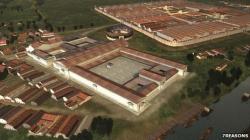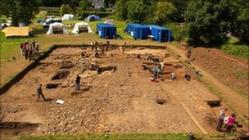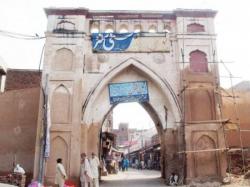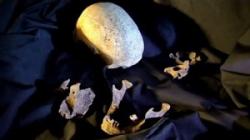- 06 - 07 AOÛT
- INDI-UNI : 
PRE-INSCRIPTION : 15 Juin – 15 Août
PRE-REGISTRATION: June 15th - August 15th
- ROYAUME UNI – 
 Caerleon - A four-week excavation is starting on new finds outside Caerleon's fortress in south Wales, one of Britain's best known Roman sites. Archaeologists from Cardiff University think the remains could include a quayside, markets and temples. They hope the new dig will provide a better understanding about the importance of the town all those years ago. The discovery was made by chance in 2010. It is possible the buildings, which may include baths and temples, are first evidence of Roman plans to develop Caerleon into a major settlement. Caerleon (Isca), which dates from AD 75, is one of three permanent legionary fortresses in the UK, and was used for 200 years. The others at Chester and York - are mostly buried and difficult to excavate. Students using geophysical equipment in fields outside the Roman fortress made the find in an area that was not thought to have been extensively occupied in the Roman period. They and their tutors then found the outlines of a series of huge buildings squeezed into the ground between the amphitheatre and the River Usk. The discovery was made as part of ongoing university excavations. Over the last five years, eight previously unknown barrack blocks have been found at Caerleon, along with three large granaries, a monumental metal workshop and a very large store building. "The presence of this suburban complex implies that the fortress was intended to become a major administrative centre in western Roman Britain, but for some reason this never happened," said Dr Peter Guest, a senior lecturer in Roman archaeology.
Caerleon - A four-week excavation is starting on new finds outside Caerleon's fortress in south Wales, one of Britain's best known Roman sites. Archaeologists from Cardiff University think the remains could include a quayside, markets and temples. They hope the new dig will provide a better understanding about the importance of the town all those years ago. The discovery was made by chance in 2010. It is possible the buildings, which may include baths and temples, are first evidence of Roman plans to develop Caerleon into a major settlement. Caerleon (Isca), which dates from AD 75, is one of three permanent legionary fortresses in the UK, and was used for 200 years. The others at Chester and York - are mostly buried and difficult to excavate. Students using geophysical equipment in fields outside the Roman fortress made the find in an area that was not thought to have been extensively occupied in the Roman period. They and their tutors then found the outlines of a series of huge buildings squeezed into the ground between the amphitheatre and the River Usk. The discovery was made as part of ongoing university excavations. Over the last five years, eight previously unknown barrack blocks have been found at Caerleon, along with three large granaries, a monumental metal workshop and a very large store building. "The presence of this suburban complex implies that the fortress was intended to become a major administrative centre in western Roman Britain, but for some reason this never happened," said Dr Peter Guest, a senior lecturer in Roman archaeology.
http://www.bbc.co.uk/news/uk-wales-14400654
- ROYAUME UNI – Paxton - Human remains dating back to the Bronze Age could lead to new information about how ancient Scots lived their lives, after a landmark find by a team of archaeologists in the Borders. Scientists believe the discovery of the skeleton in east Berwickshire could open a new window into the lives of Scots more than 4,000 years ago. The body, which is believed to belong to an adult because of its worn teeth, was buried with a pot which could be as much as 4500 years old, according to experts. The skeleton was found on the site of a former Norman Church at the Fishwick site in the village of Paxton. The pot has been identified as from the start of the Bronze Age - around 2,400BC. Mr Bowles believes the discovery could be part of a wider burial and could lead to further information about the role of religion in the Borders. Kritisian Pedersen, who is co-heading the project, said: "This will be significant in our understanding of the early Bronze Age in Scotland. "Bronze Age burials have been uncovered elsewhere but none have shown up in the Borders for a long time and the last time was before we have all the technology that we have now." The Paxton area was originally part of the Kingdom of Bernicia and later became part of the Kingdom of Northumbria. Last year, Bronze Age tools dating back to around 1500BC were discovered at another part of the site.
http://www.scotsman.com/news/Bronze-Age-find-shines-a.6813264.jp?articlepage=1
- BULGARIE – Sofia - The metro station in Sofia downtown may soon happen to house the residence of Byzantine Emperor Constantine I. The archeologists have not confirmed for sure the identity of the findings as excavations continue. All facts for now, however, lean towards the variant that the palace of the first Christian Emperor lies just under the square in front of St Nedelya Church. A unique dwelling and a church from the 4th century have been the most recent sensation that came up from Sofia’s underground depths. “The well-preserved building must have belonged to a noble citizen of Serdica,” explained archeologist Mario Ivanov from the Bulgarian Academy of Science. There is a bathroom, yard and a bakery in the building. The most precious finding, however, is the 30sq.m of mosaics. Such a large mosaic preserved with all the ornaments is vary rare to find, so far only separate parts have been discovered, experts commented.
http://paper.standartnews.com/en/article.php?d=2011-08-05&article=36947
- TURQUIE – Kaunos - Kaunos Ancient City, found in the Ortaca area of Dalyan town is well-known for its ancient history. Its archaeological excavations, which began in 1966 and are still continuing, usually produce rich discoveries. Archaeologist Erkan Kart, who participates in the area digs, said, that new excavations in the Ortaca area revealed a basilica from Roman times, an agora and Demeter’s holy venues. “The basilica venue in the excavation revealed that there were spaces devoted to shopping, trade and legal institutions in the Roman times,” Kart said. “The excavation work includes conservation, restoration and an archaeological park. We will determine the depth of these venues in our continued research,” he added. “On the other hand, the preservation of the rock tombs found in the excavations, will begin in September. The nanotechnology-based protection system will be activated in September and will last ten years.” The rock tombs have an ancient history of 2,400 years and the team will use nanotechnology to preserve and protect those tombs.“Apart from Kaunos excavation works, another big project is waiting for the Turkish archaeology team,” said the archaeologist, adding that the team is working to protect rock tombs from sunlight and rain.
http://www.hurriyetdailynews.com/n.php?n=rock-tombs-to-be-protected-by-a-new-nanotechnology-system-2011-08-05
- PAKISTAN –  Lahore - The government will need to remove a host of encroachers and line drains in order to restore and conserve four historic Walled City gates. Archaeology Department officials began restoring Sheranwala Gate in June and expect to be finished in November. Only five of the 12 original gates of the Walled City still remain. Four of them were heavily altered by the British. Roshnai Gate, joining the Lahore Fort and Badshahi Masjid, remains the only one in its original state.
Lahore - The government will need to remove a host of encroachers and line drains in order to restore and conserve four historic Walled City gates. Archaeology Department officials began restoring Sheranwala Gate in June and expect to be finished in November. Only five of the 12 original gates of the Walled City still remain. Four of them were heavily altered by the British. Roshnai Gate, joining the Lahore Fort and Badshahi Masjid, remains the only one in its original state.
http://tribune.com.pk/story/225845/walled-city-gates-restoration-faces-major-challenges/
- USA –  – Texas - The Texas drought is proving quite good for history, but not so good for Texas itself. Just within the past few days there has been another piece of history unearthed as the drought continues to take its toll on rivers, lakes and other bodies of water. The find was quite a stunning one : two graves of plantation slaves, buried under a reservoir that has dried up. The graves are thought to have been buried and unknown about for over a century. It's an amazing find for the world of archaeology, but it's too bad that the water had to dry up in order to find it.Any cemeteries lying in the place where the reservoir was going to be was moved back during the 1980's when it was built. These two plantation slaves graves were unmarked, with no tombstones, so they were left as is and covered with water as the reservoir filled.
– Texas - The Texas drought is proving quite good for history, but not so good for Texas itself. Just within the past few days there has been another piece of history unearthed as the drought continues to take its toll on rivers, lakes and other bodies of water. The find was quite a stunning one : two graves of plantation slaves, buried under a reservoir that has dried up. The graves are thought to have been buried and unknown about for over a century. It's an amazing find for the world of archaeology, but it's too bad that the water had to dry up in order to find it.Any cemeteries lying in the place where the reservoir was going to be was moved back during the 1980's when it was built. These two plantation slaves graves were unmarked, with no tombstones, so they were left as is and covered with water as the reservoir filled.
http://news.gather.com/viewArticle.action?articleId=281474979827082
- ROYAUME UNI – Mexborough - Archaeologists have been exploring Mexborough’s industrial past before it disappears beneath a new Lidl store in the town’s Cliff Street. And they’ve uncovered evidence of a ground-breaking glass-making factory which churned out pop bottles in their tens of thousands. The dig has been at the site of the former New Don Glassworks, one of the first in Yorkshire to recycle heat and gases created in the process. In 1891 the land was bought for £4,000 by Peter Waddington, who was the owner of the Mexborough Phoenix Glasshouse. He built the New Don Glassworks. Much of the works was demolished in the 1950s.
http://www.southyorkshiretimes.co.uk/news/local/dearnearea/glass_find_opens_a_window_on_the_past_1_3653003
- INDE – Pattanam - The effort made by some interested quarters to link the Muziris excavations with the visit of St Thomas Apostle has been criticised by eminent archaeologist and former director of the Tamil Nadu Archaeological Survey of India R Nagaswamy. "When looking at the literature on the life of St Thomas, it is not mentioned anywhere that he came to India. It is only a myth, which has now been connected with the excavations at Pattanam, near Kodungalloor. In fact, the ancient Muzirs port must have been located in Kodungalloor and not in Pattanam because all major ports in ancient times were situated at river mouths. And so it is safe to assume that Muziris was at Kodungalloor, where the river joins the sea. He felt there was a hidden agenda by certain sections to propagate the idea thatw Muziris was connected to Pattanam, where St Thomas is believed to have landed, and not with Kodungalloor. Myth cannot be called history. Connecting myth with history could only create confusion and distort history, he said. "There is no substantial evidence to say that Pattanam is connected with Muziris. How was this conclusion reached? Those who claim to have found materials to connect Pattanam with Muziris have forgotten that these materials were also found in the eastern and the western costs of the country," said Nagaswamy.
http://ibnlive.in.com/news/expert-nails-false-propaganda-on-muziris/173537-60-116.html